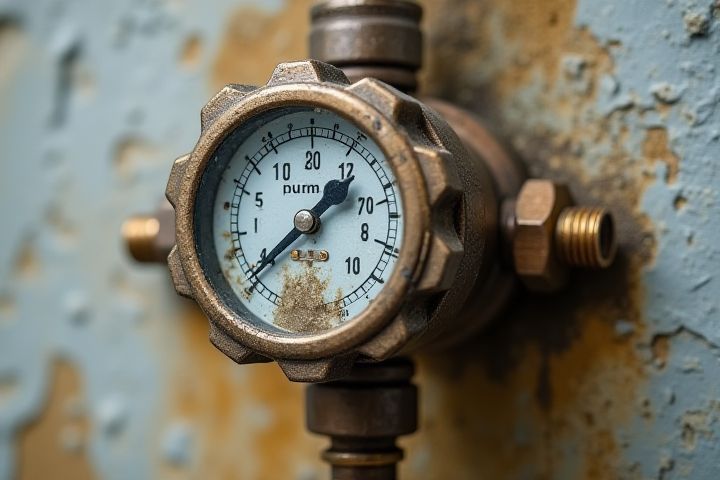
Low water pressure in a house may be caused by various factors, including pipe blockages, leaks in the plumbing system, or faulty fixtures. Sediment buildup in pipes can restrict water flow, leading to diminished pressure. Additionally, if there are leaks in your plumbing system, water may escape, reducing the overall pressure experienced at taps and fixtures. It's also possible that the municipal water supply has low pressure in your area, particularly during peak usage times. Regular maintenance, such as flushing the water heater and checking for leaks, can help manage and improve your water pressure.
Why Would A House Have Low Water Pressure
Pipe corrosion
Pipe corrosion can significantly contribute to low water pressure in your home. Over time, minerals and chemical reactions can cause the interior of pipes to corrode, leading to buildup that restricts water flow. In older homes, galvanized steel or iron pipes are often more susceptible to corrosion, which can cause leaks and decreased pressure. Regular maintenance and inspections can help identify corroded pipes before they escalate into major plumbing issues, ensuring optimal water pressure.
Mineral buildup
Low water pressure in a house can often be attributed to mineral buildup within plumbing systems, particularly in pipes and fixtures. Over time, hard water deposits, mainly calcium and magnesium, accumulate and restrict water flow, leading to noticeable pressure drops. Homes in areas with high mineral content in their water supply are especially susceptible, as these deposits can significantly impair flow rates. Regular maintenance, including descaling treatments, can help restore optimal water pressure and prolong the lifespan of your plumbing system.
Valve issues
Low water pressure in a house can often be attributed to faulty valves. One common issue is a partially closed main shut-off valve, which can restrict water flow and significantly decrease pressure. Another potential problem is a malfunctioning pressure-reducing valve (PRV), failing to regulate incoming water pressure to an optimal range (usually between 40-60 psi). Over time, sediment buildup or corrosion in these valves can also impede water flow, leading to inconvenient low pressure throughout your plumbing system.
Leaks in plumbing
Low water pressure in your home may often stem from leaks in the plumbing system. Even minor leaks can cause significant pressure drops, as water escapes from the system before reaching your faucets and fixtures. For example, a small leak can waste approximately 10,000 gallons of water annually, impacting both your water bill and pressure levels. Regularly checking for signs such as dampness, increased water bills, or unusual noises in pipes can help you identify and address these leaks promptly.
Obstructed aerators
Obstructed aerators can significantly contribute to low water pressure in your house, often manifesting as reduced flow from faucets and showerheads. These small devices, located at the tip of faucets, can accumulate mineral deposits, dirt, and debris over time, leading to a blockage that restricts water flow. Maintaining an unobstructed aerator is crucial; a blockage can reduce water pressure by up to 50%, affecting your daily activities. Regular cleaning or replacement of aerators can restore optimal water pressure, ensuring efficient water usage and enhancing your overall plumbing experience.
Faulty pressure regulator
A faulty pressure regulator can significantly contribute to low water pressure in your home. This device, typically located near the main water line, controls the flow of water into your plumbing system, and if malfunctioning, it may reduce pressure to below the desired 40-60 psi range. You might notice symptoms such as weak showers or slow-filling faucets, indicating that the regulator needs adjustment or replacement. Regular maintenance and inspections of this component can help ensure optimal water pressure and overall system efficiency.
Clogged filters
Low water pressure in your home can often be attributed to clogged filters within your plumbing system. Over time, sediment, minerals, and debris can accumulate in water filters, reducing the flow of water to your faucets and fixtures. Regular maintenance, including cleaning or replacing these filters every 6 to 12 months, is essential to ensure optimal water pressure. If you're experiencing persistent low pressure, checking and addressing clogged filters should be one of your first troubleshooting steps.
Shared water supply
A house may experience low water pressure due to its reliance on a shared water supply system, which diverts a portion of the available water to multiple residences. This can lead to diminished flow rates, especially during peak usage times, when several households are drawing water simultaneously. Water pressure issues can also stem from aging infrastructure or sediment buildup in pipes, further compromising the supply. If your home is located at the end of a water main, the distance from the source can exacerbate these pressure troubles.
Low municipal pressure
Low municipal water pressure can significantly affect your home's water supply, resulting in frustratingly reduced water flow from taps and fixtures. This condition often stems from inadequate municipal infrastructure or high demand during peak usage times, such as early mornings or late evenings. In some cases, the pressure may drop to below 30 psi, which is typically considered the minimum acceptable level for residential use. If you're experiencing low water pressure, you may want to contact your local water utility to investigate potential issues within the municipal system or consider installing a pressure booster system for improved flow.
Inefficient pump system
An inefficient pump system can significantly contribute to low water pressure in your home, often resulting from age or mechanical wear. When pumps fail to maintain the necessary pressure levels, the result is inadequate water flow, which can affect showers, faucets, and appliances that rely on consistent water supply. Furthermore, sediment buildup in the pump or piping can impair water movement, leading to a drastic pressure reduction. Investing in a high-efficiency pump system may resolve these issues, ensuring a reliable water supply and improved pressure levels throughout your home.
